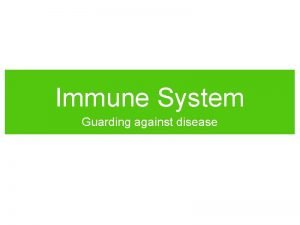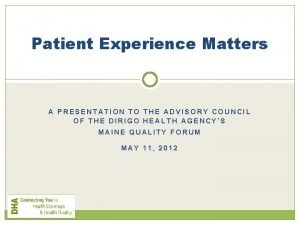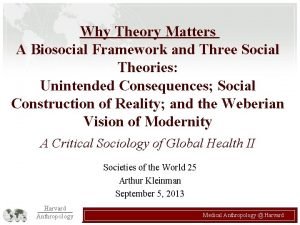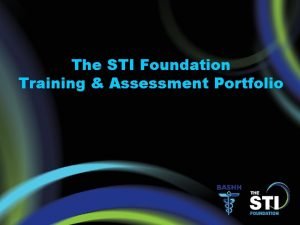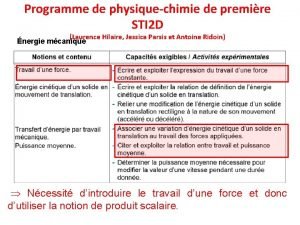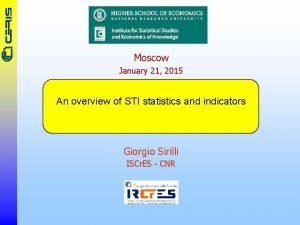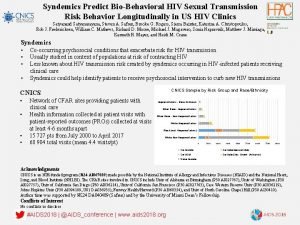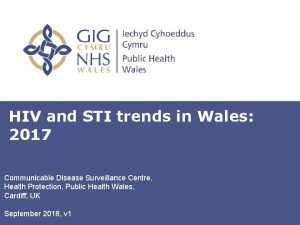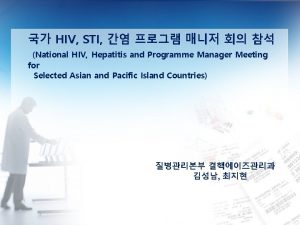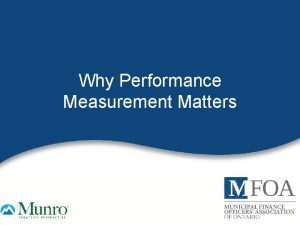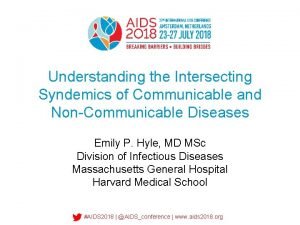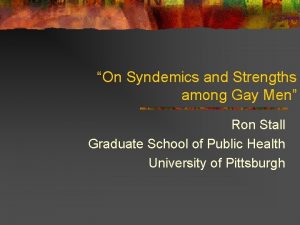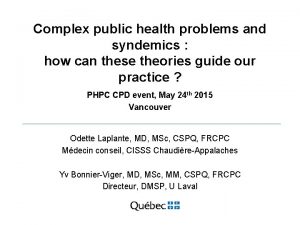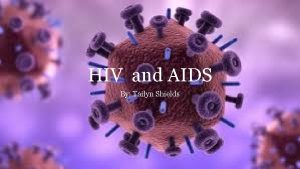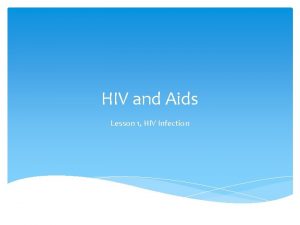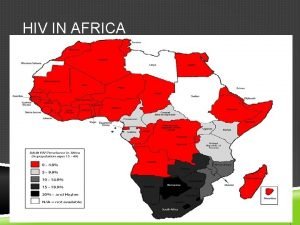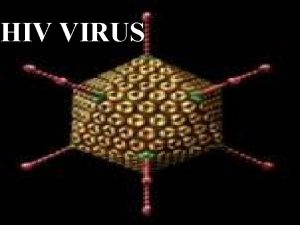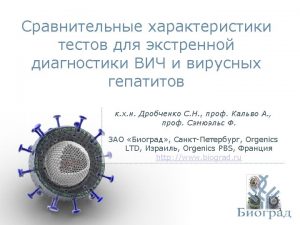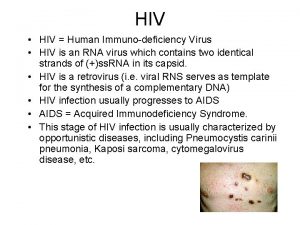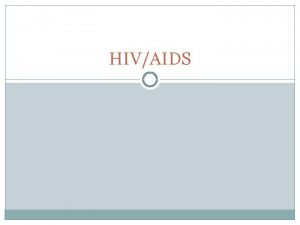HIV and STI Why Addressing These Syndemics Matters






















- Slides: 22

HIV and STI: Why Addressing These Syndemics Matters Kenneth H. Mayer, MD IAS 2019, Mexico City July 24, 2019

Epidemiological Synergy Interrelationships between Human Immunodeficiency Virus Infection And Other Sexually Transmitted Diseases JUDITH N. WASSERHEIT, MD, MPH From the Sexually Transmitted Diseases Branch, National Institute of Allergy and Infectious Diseases, National Institutes of Health, Bethesda, Maryland Sex Transm Dis. 1992 Mar-Apr; 19(2): 61 -77

The Old Paradigm: Pre-HAART Biology (inflammation/ulceration) Behavior STI (condomless sex, ↑ partners) Epidemiology (risky partners, core group) Immune suppression HIV

The New Paradigm: After U=U and Pr. EP Biology (inflammation/ulceration) Behavior STI X Pr. EP (condomless sex, ↑partners) U=U & Pr. EP Epidemiology Immune suppression X x (risky partners, core group) HIV U=U

WHO estimates 357 million new cases of four curable STIs in 15 -49 year-olds in 2012 > 1 million new cases of STI / day Curable STIs: chlamydia, gonorrhea, syphilis, trichomoniasis Source: WHO. Global incidence and prevalence of selected curable sexually transmitted infections - 2012. Slide 5 www. iasociety. org

Prevalence of STIs in sub-Saharan Africa: Individual patient data meta-analysis of 18 HIV prevalence studies 15 – 24 years old 100 25 – 49 years old 100 South Africa community 90 80 Southern Afr/Eastern Afr community 90 Southern Afr/Eastern Afr High Risk 80 70 South Africa SA/EA community SA/EA HR 70 60 56. 3 50 46. 8 39. 3 40 83. 3 77. 8 70 60 50 40 30 Go no r V on as yd am HS V Ch l om on as lis Tr ich Sy ph i a rh oe Go no r yd ia am Ch l om 0 1 0. 92. 8 8. 6 10 5. 8 ich 10 7. 96. 7 lis 4. 5 0. 41. 1 6. 7 5. 2 2. 50. 9 1. 2 ia 0 4. 6 1. 7 7 Tr 2. 7 8. 2 Sy ph i 10 10. 3 20 12. 7 a 15. 1 rh oe 20 HS 30 BV was high among 25– 49 year-olds range: 33– 44% Torrone EA, Morrison CS, Chen PL, Kwok C, Francis SC, et al. PLo. S Med. February 2018.

HIV is highly co-prevalent among patients presenting with STI syndromes in South Africa, 2014 -2016 STI syndrome N= HIV co-infected Per cent HIV positive Genital Ulcer Disease 363 208 57. 3% Vaginal Discharge 742 350 47. 2% Male urethral discharge 784 211 26. 6% There was a significant association between HIV seropositivity and all STI syndromes (p<0. 001). Source: Ranmini Kularatne, Centre for HIV & STIs, NICD. Aetiological Surveillance of Sexually Transmitted Infection Syndromes at Sentinel Sites: Germs-SA 2014 -2016. The Communicable Diseases Surveillance Bulletin, Volume 15. Issue 3 – November 2017. http: //www. nicd. ac. za/index. php/publications/communicable-diseases-surveillance-bulletin/

Rectal gonorrhea and syphilis are predictive of future HIV infection Katz et al. Sex Trans Dis. 43(4): 249 -254, 2016. Also Bernstein et al from SF and Pathela et al from NYC

STIs among MSM in South Africa and Nigeria STI among MSM in Nigeria � Lagos Gonorrhea 28. 1% Chlamydia 18. 3% Syphilis 19. 6% � All Asymptomatic STI among MSM in South Africa Source : Babajide Keshinro, MHRP, Nigeria, Kevin Rebe, Anova Health Institute, South Africa

Figure 10 New diagnoses of HIV and STIs from 1996 to 2015 in MSM in England Unemo M et al. Lancet Infect Dis 2017

Meta-Analyis of Effect of Pr. EP on STIs Diagnosis among MSM • • • Significant increase in any rectal STI diagnosis (OR: 1. 39, 95% CI: 1. 03 -1. 87) Significant increase in rectal chlamydia (OR: 1. 59, 95% CI: 1. 19 -2. 13) Increase in STIs rates in more recent studies (OR: 1. 47, 95% CI: 1. 05 -2. 05) Traeger MW et al. CID 2018

Figure 11 Community-Level Changes in Condom use with Casual Partners Among MSM 30% 1% 46% The Lancet Infectious Diseases 2017 17, e 235 -e 279 DOI: (10. 1016/S 1473 -3099(17)30310 -9) Copyright Holt M. et al. Lancet HIV 2018

Increasing bacterial STI rates include HIV+ and HIV- GC, CT, Syphilis, by HIV status and Pr. EP Use (Fenway Health, 2005 -2015) 100% 1600 90% 1400 80% 1200 70% 1000 60% 50% 800 40% 600 30% 400 20% 200 10% 0% 0 2005 2006 2007 2008 % HIV-/No Pr. EP 2009 2010 % HIV-/Pr. EP 2011 2012 % HIV+ 2013 2014 2015 Total Cases Mayer, OFID, 2017

Testing for STIs in Last 12 months among MSM – an e. CDC/Hornet Survey n=8613 n=690 31% Of those currently not on Pr. EP those. Pr. EP Men. Oftaking onfor testcurrently more often STIs Pr. EP 69% Noori T. et al EACS 2017

Reducing STI by increasing screening 100% 97% 94% 88% 80% 91% 77% 70% 60% 50% 40% 30% 20% 10% 0% 3% Easy Uncomfortable Instructions easy Prefer to collect Test more often Collect at home Recommend to to follow own a friend Menza et al. IDWeek, 2018.

Reducing STI through improved services

Beyond Syndromic Management: Multiple etiologies of vaginal discharge in South Africa: 2014 -2016 60% 56. 00% 50% 40% 30% 22. 00% 20% 18. 50% 19. 00% 17. 70% 15. 00% 10% 0% % Pathogens N. gonorrhoeae 18. 50% C. trachomatis 17. 70% T. vaginalis 15. 00% M. genitalium 10. 00% BV 56. 00% Candida 22. 00% No pathogen 19. 00%


Need to Address Behavioral Health Syndemics: Depression and HIV/STIs among MSM in Lesotho 527 MSM completed structured survey instrument, biologic testing for HIV and Syphilis � Defined positive depression screen as a PHQ-9 score of 10 or more Outcome variable Adjuste 95% d Odds Confidence Ratio Interval Laboratory test result Positive for syphilis 2. 75* 1. 07, 7. 08 Positive for HIV 1. 58 0. 85, 2. 94 Diagnosed with any STI, past 12 months 2. 04* 1. 02, 4. 06 Diagnosed with HIV, ever 1. 27 0. 61, 2. 63 Self-report Sources: Stahlman, Baral, et al. Depression and Social Stigma among MSM in Lesotho: Implications for HIV and Sexually Transmitted Infection Prevention. Forthcoming

Incidence of Gonorrhea and Chlamydia among MSM using Pr. EP Over the next decade, 40% of NG and CT infections would be averted (40% Pr. EP coverage) Jenness et al CID 2017

Conclusions § High rates of condomless sex and STI do not undermine high efficacy of ART to prevent HIV transmission or acquisition § BUT, STI will continue to potentiate HIV spread until all PLHIV have access to rx. and all at risk persons can access Pr. EP § STI continue to be major sources of morbidity in their own right § Frequent testing, early diagnosis and treatment and better partner notification should help reduce HIV and STI incidence § STI and HIV services provide gateways to testing, diagnoses, and treatment, leading to improved sexual health. § Community engagement is key to counter the increase in STI associated with biomedical interventions, and should address concomitant syndemic issues (e. g. behavioral health)

Thank you Stef Baral Chris Beyrer Myron Cohen Jeanne Marrazzo Tim Menza Jean-Michel Molina Francis Ndowa Kevin Rebe Steven A. Safren Patrick Sullivan Teodora Wi NIAID, NIMH, NIDA, NICHD, CDC, HRSA, Mass DPH, Gilead www. fenwayhealth. org
 Flat addressing vs hierarchical addressing
Flat addressing vs hierarchical addressing Pictures
Pictures Dot
Dot Why punctuation is important
Why punctuation is important Why productivity matters
Why productivity matters Waste container lid
Waste container lid Why was every child matters scrapped
Why was every child matters scrapped Why patient experience matters
Why patient experience matters Why closing the word gap matters
Why closing the word gap matters Biosocial framework
Biosocial framework Why data governance matters
Why data governance matters Why productivity matters
Why productivity matters Why motivation matters
Why motivation matters Why civility matters
Why civility matters Length of diffusion effect
Length of diffusion effect Dont ask why why why
Dont ask why why why Pemti
Pemti Stif competencies
Stif competencies Sexually transmitted diseases
Sexually transmitted diseases Programme première sti2d physique-chimie
Programme première sti2d physique-chimie Sti university moscow
Sti university moscow Sti 2 d
Sti 2 d Staunch synonym
Staunch synonym


